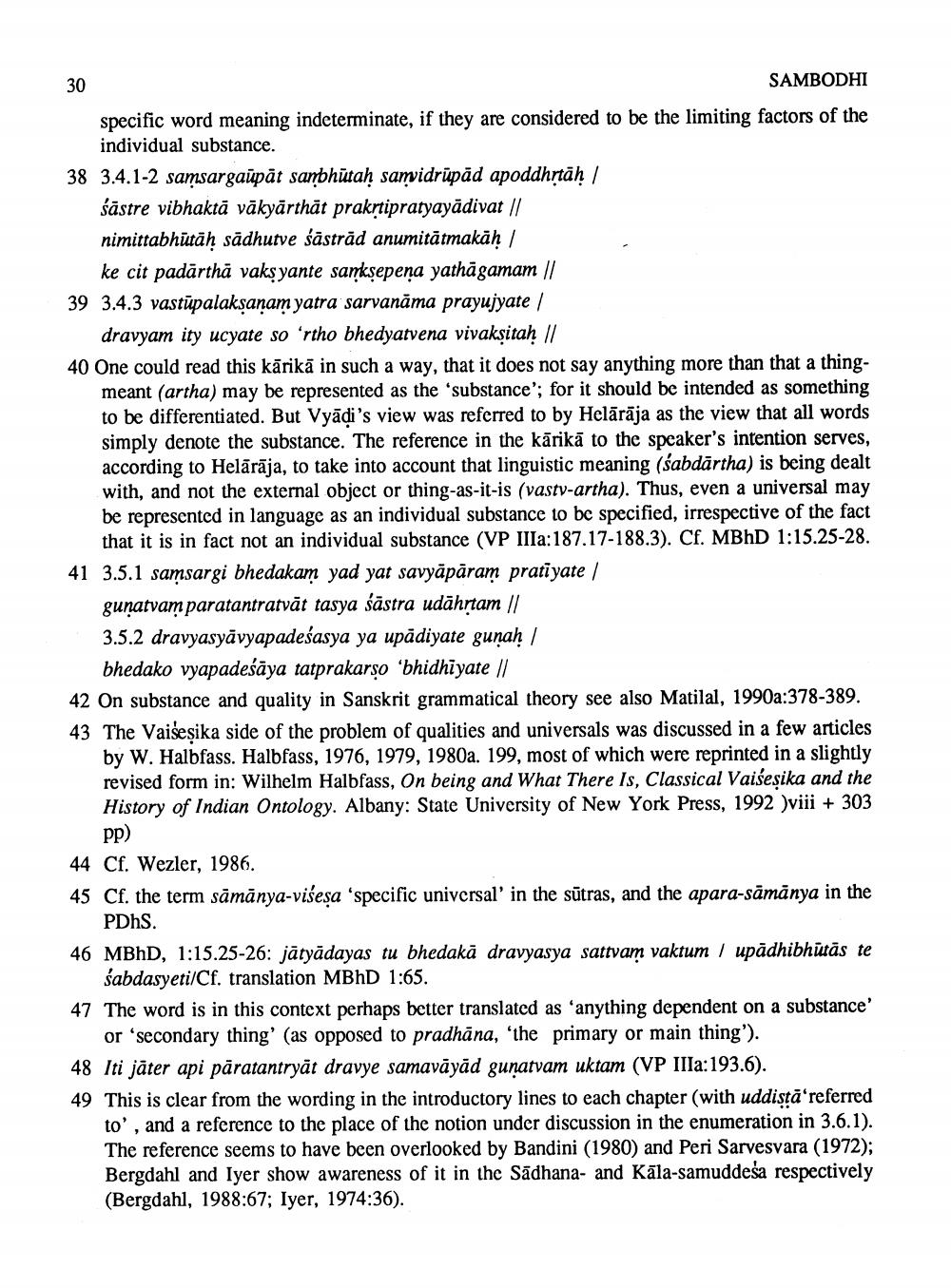________________
30
SAMBODHI
specific word meaning indeterminate, if they are considered to be the limiting factors of the
individual substance. 38 3.4.1-2 samsargaupāt sanbhūtaḥ samvidrūpād apoddhrtāḥ /
śāstre vibhaktā vākyārthāt prakrtipratyayādivat // nimittabhūtāḥ sādhutve śāstrād anumitätmakäḥ /
ke cit padārthā vaks yante sanksepeņa yathāgamam // 39 3.4.3 vastūpalakṣaṇam yatra sarvanāma prayujyate
dravyam ity ucyate so‘rtho bhedyatvena vivaksitaḥ 11 40 One could read this kārikā in such a way, that it does not say anything more than that a thing
meant (artha) may be represented as the 'substance'; for it should be intended as something to be differentiated. But Vyādi's view was referred to by Helārāja as the view that all words simply denote the substance. The reference in the kārikā to the speaker's intention serves, according to Helārāja, to take into account that linguistic meaning (sabdārtha) is being dealt with, and not the external object or thing-as-it-is (vastv-artha). Thus, even a universal may be represented in language as an individual substance to be specified, irrespective of the fact
that it is in fact not an individual substance (VP IIIa:187.17-188.3). Cf. MBHD 1:15.25-28. 41 3.5.1 samsargi bhedakam yad yat savyāpāram pratiyate /
gunatvam paratantratvāt tasya śāstra udāhrtam // 3.5.2 dravyasyāvyapadeśasya ya upādiyate guṇaḥ/
bhedako vyapadeśāya tatprakarso 'bhidhīyate // 42 On substance and quality in Sanskrit grammatical theory see also Matilal, 1990a:378-389. 43 The Vaišesika side of the problem of qualities and universals was discussed in a few articles
by W. Halbfass. Halbfass, 1976, 1979, 1980a. 199, most of which were reprinted in a slightly revised form in: Wilhelm Halbfass, On being and What There Is, Classical Vaisesika and the History of Indian Ontology. Albany: State University of New York Press, 1992 )viii + 303
pp) 44 Cf. Wezler, 1986. 45 Cf. the term sāmānya-višesa 'specific universal' in the sūtras, and the apara-sāmānya in the
PDhS. 46 MBhD, 1:15.25-26: jātyādayas tu bhedakā dravyasya sattvam vaktum / upādhibhūtās te
śabdasyeti/Cf, translation MBHD 1:65. 47 The word is in this context perhaps better translated as “anything dependent on a substance'
or 'secondary thing' (as opposed to pradhāna, 'the primary or main thing'). 48 Iti jāter api pāratantryāt dravye samavāyād gunatvam uktam (VP IIIa:193.6). 49 This is clear from the wording in the introductory lines to each chapter (with uddistā'referred
to', and a reference to the place of the notion under discussion in the enumeration in 3.6.1). The reference seems to have been overlooked by Bandini (1980) and Peri Sarvesvara (1972); Bergdahl and Iyer show awareness of it in the Sādhana- and Kāla-samuddesa respectively (Bergdahl, 1988:67; Iyer, 1974:36).




